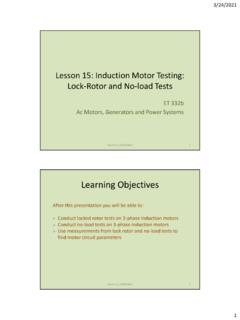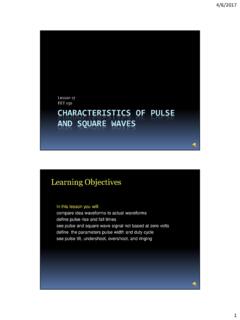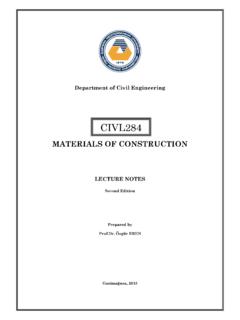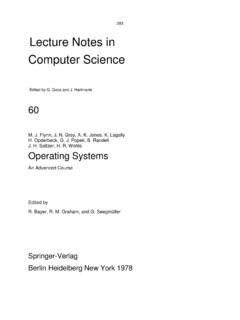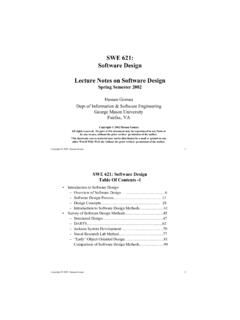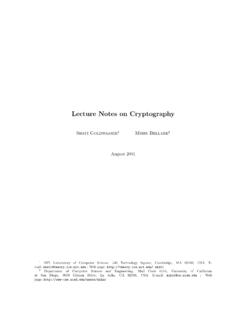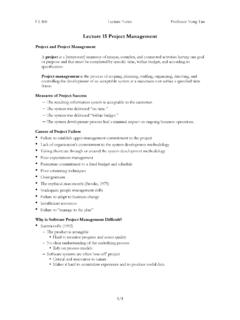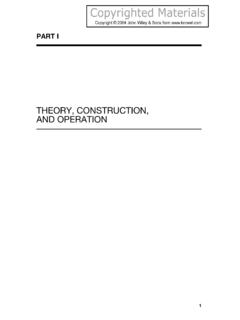Transcription of CHAPTER 1 THE SAFETY AND HEALTH MANAGER
1 2004 SAFETY lecture notes Page 1 CHAPTER 1 THE SAFETY AND HEALTH MANAGER Everyone wants a safe and healthful workplace, but what each person is willing to do to achieve this worthwhile objective can vary a great deal. Management of each firm must decide at what level, along a broad spectrum, the SAFETY and HEALTH effort will be A continuum between personal freedom and individual responsibility. It has been proven that the attitude of the worker is the most important determinant for his or her SAFETY , but attitude alone cannot make a dangerous job safe. The SAFETY director or industrial hygienist, sets the tone of the SAFETY and HEALTH program within a firm. It was not unusual for a SAFETY director's work to be typified by public relations activities, such as posting motivational signs and compiling statistics.
2 In the 1970 s the passage of the occupational SAFETY and HEALTH act of 1970 created the occupational SAFETY and HEALTH administration (OSHA), a federal agency whose regulations would have a large impact on the role of the typical SAFETY director. There is little doubt that OSHA enhanced the authority of the SAFETY MANAGER in the typical industrial plant in the United States. The field of occupational HEALTH has probably benefited more from OSHA than has the field of occupational SAFETY . This text will use the designation SAFETY and HEALTH MANAGER , recognizing the dual nature of the job. The purpose of this book is to provide tools and guidelines to SAFETY and HEALTH managers to help them execute their enlarged duties. Dealing with applicable standards is one of the greatest challenges facing today's SAFETY and HEALTH MANAGER .
3 10% of the standards generate 90% of the frequently cited standards and receive prime attention. SAFETY and HEALTH managers need to know the "why" behind the standards. A Reasonable Objective In the real world we must choose between these three categories of hazards with respect to feasibility of correction: 1. Hazards that are physically infeasible to correct 2004 SAFETY lecture notes Page 2 2. Hazards that are physically feasible, but are economically infeasible to correct 3. Hazards that are economically and physically feasible to correct This book does not really advocate elimination of all workplace hazards. Such a goal is unattainable, and to reach for it is poor strategy because it ignores the need for discriminating among hazards to be corrected. Case Study Page 3 By reacting to every hazard that happens to show up, the SAFETY and HEALTH MANAGER may be missing opportunities to have a really significant impact on worker SAFETY and HEALTH .
4 Even the law does not call for the elimination of all hazards, just the "recognized" ones. The goal of this book is to assist the SAFETY and HEALTH MANAGER in detecting hazards and in deciding which ones are worth correcting. SAFETY Versus HEALTH What is the difference between SAFETY and HEALTH ? A machine guard is a SAFETY consideration, and airborne asbestos is a HEALTH hazard, but some hazards, such as those associated with paint spray areas and welding operations, are not so easy to classify. Some situations may be both a HEALTH and a SAFETY hazard. This book will draw the following line between SAFETY and HEALTH : SAFETY deals with acute hazards, whereas HEALTH deals with chronic hazards. An acute effect is a sudden reaction to a severe condition; a chronic effect is a long-term deterioration due to a prolonged exposure to a milder adverse condition.
5 Noise can be both acute and chronic; sudden exposure to high decibels or long term exposure to 90-100 decibels. Degree of hazard is another point of contention between SAFETY and HEALTH : both sides think their hazards are more grave. SAFETY professionals can point to fatalities on the job and feel an urgency in protecting the worker from imminent danger from accidents. However there are probably more occupational HEALTH fatalities than SAFETY fatalities, but the statistics will not reflect this difference because the HEALTH fatalities are delayed and are often never diagnosed. Role In The Corporate Structure 2004 SAFETY lecture notes Page 3 Some SAFETY and HEALTH managers are also personnel managers, and even more frequently they report to the personnel MANAGER . They can be responsible for training, statistics, job placement and industrial relations with respect to SAFETY and HEALTH .
6 Purchasing, however, is never associated with the SAFETY and HEALTH MANAGER s responsibilities ..but according to the text should be. With respects to the purchase of new equipment, the sooner the SAFETY MANAGER gets involved in the purchasing process the sooner he can inject his opinion as to what is the safest equipment to purchase based upon a SAFETY analysis. A recent concept of the SAFETY and HEALTH MANAGER is as a liaison with government agencies, a condition brought about by the arrival of OSHA. Some SAFETY and HEALTH managers have a dual responsibility for environmental protection (EPA) activities. The consumer product SAFETY commission (CPSC) concentrates on the responsibility of the manufacturers of the machines and equipment, whereas OSHA concentrates on the responsibility of the employer who places the equipment into use in the workplace.
7 Resources At Hand (Page 6) A variety of resources have arisen to meet these needs of the SAFETY and HEALTH Professional. Professional Certification Professional Societies National SAFETY Council Standards Institutes Trade Associations Government Agencies - free consultation - The National Institute For Occupational SAFETY And HEALTH (NIOSH) has a wealth of research data on the hazards of specific materials and processes. -NIOSH uses these data to write criteria for recommended new standards. - OSHA itself can be of value to the SAFETY and HEALTH MANAGER who seeks information. CHAPTER 2 Development of the SAFETY and HEALTH function 2004 SAFETY lecture notes Page 4 To make workers aware of hazards, supervisors and the workers themselves need regular training in hazard recognition and correction.
8 Statistics and accident records are needed to keep management and operating personnel advised of how well the company and its departments are doing in achieving their SAFETY and HEALTH goals. Workers' Compensation Workers' compensation provided an initial structure to industrial SAFETY . The first such laws were introduced in state legislatures in 1909, and now all states have comparable legislation. The purpose of workers' compensation legislation is protecting the worker by providing statutory compensation levels to be paid by the employer for various injuries that may be incurred by the worker. This provokes labor to be dissatisfied with the workers' compensation system. Table lists examples of statutory compensation levels. Typically, the firm does not pay the workers' compensation payments directly; rather, it carries insurance against compensation claims.
9 "Experience Rating," expressed as a decimal fraction to be multiplied by the standard premium rate. The experience rating is based upon a three-year average of the firm's actual claims experience and can be less than or greater than The number of employees is not criteria used in the computation of premium rate (see Page 33). A good insurance company will make regular inspections of facilities to be sure that installations and practices are safe. This is a direct and measurable monetary stimulus to the SAFETY program. Some companies choose to self-insure against workers' compensation claims. The insurance companies are valuable sources of technical advice to their clients. The number of companies that have elected to self-insure has led to a new type of consultant called a Loss Control Representative.
10 This consultant's objective is to keep workers' compensation claims low by supplying the type of services normally provided by the insurance carrier. Recordkeeping 2004 SAFETY lecture notes Page 5 The national SAFETY council established the first national system of industrial SAFETY recordkeeping. This system was standardized and designated the system by the American National Standards Institute. In the 1970s, the Federal OSHA agency set mandatory recordkeeping requirements very similar to the system. Traditional Indexes Familiar statistical measures are frequency and severity. Frequency measured the numbers of cases per standard quantity of workhours, and severity measured the total impact of these cases in terms of "lost workdays" per standard quantity of workhours.



